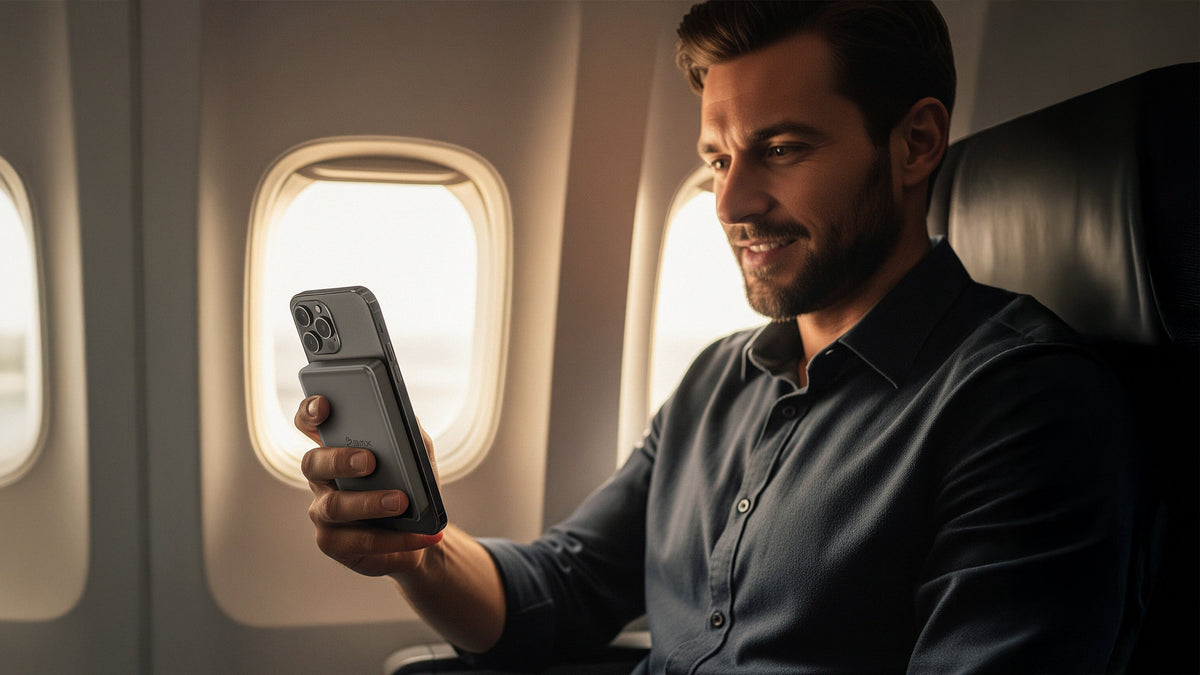
Power Bank Bans Are Spreading on Airlines: What You Need to Know Before You Fly
|
|
Time to read 3 min
|
|
Time to read 3 min
Can I Still Bring a Power Bank on a Plane in 2025?
Yes. But the rules are stricter than ever, and they now vary widely between airlines. Carriers around the world have tightened restrictions on power banks because of growing safety concerns. In 2025, Singapore Airlines, Scoot, Southwest, and all major Korean airlines began banning in-flight charging and enforcing stricter storage requirements. Most recently, Emirates announced one of the toughest policies yet, effective October 1, 2025. If you fly with a power bank, especially internationally, you need to understand the latest rules or risk having your device confiscated or being stopped at the gate.
Most airlines still follow baseline guidelines set by the FAA, ICAO, and IATA:
Power banks are carry-on only; they are never allowed in checked bags.
Up to 100 Wh: allowed without restrictions.
101 Wh to 160 Wh: allowed only with airline approval (limit two per passenger).
Above 160 Wh: not permitted on passenger flights.
The Wh rating must be printed on the device.
Airlines increasingly require batteries to be stored under your seat or in the seat pocket, not overhead.
These rules form the foundation, but 2025 brought stricter carrier-specific policies you need to know.
Emirates introduced one of the strictest policies effective October 1, 2025. Passengers may bring only one power bank under 100 Wh. It must be stored under the seat or in the seat pocket. Charging any devices or the power bank itself during the flight is banned, and overhead bins cannot be used for storage.
Singapore Airlines and Scoot updated their policies in April 2025. Power banks up to 100 Wh are allowed, and devices up to 160 Wh require approval. In-flight charging is not permitted under any circumstance.
Korean carriers, including Korean Air, Asiana, Jeju Air, and Air Busan changed their policies after a battery fire incident in early 2025. In-flight charging is now banned, and power banks must be stored under your seat.
Cathay Pacific and Hong Kong Airlines allow power banks but require them to remain accessible to cabin crew at all times. Using them mid-flight is not allowed.
Other airlines have followed suit. EVA Air, Thai Airways, VietJet, AirAsia, Starlux, and Tigerair now prohibit in-flight charging completely. ANA and Japan Airlines require power banks to remain visible rather than stored overhead, while Lufthansa allows them onboard but does not permit mid-flight use.
Most power banks still use lithium-ion batteries, which contain flammable liquid electrolytes. If damaged, overheated, or overcharged, these batteries can enter thermal runaway, which can cause swelling, smoke, fire, or even explosions.
Recent incidents illustrate the risk:
In January 2025, a power bank caused a fire on an Air Busan flight, injuring 27 passengers.
In March 2025, smoke from a suspected battery fire forced a Hong Kong Airlines flight to divert.
In July 2025, a KLM flight cabin filled with smoke after a power bank overheated mid-flight.
The FAA reported 43 lithium battery incidents in the first seven months of 2025, double the same period the year before.
These events are driving airlines and regulators to tighten policies globally.
Before you pack, confirm these essentials:
It’s 100 Wh or less, or you’ve obtained airline approval.
The Wh rating is clearly printed on the device.
Always pack it in your carry-on, never checked.
Do not plan to use or charge it mid-flight unless your airline explicitly allows it.
Choose devices with safety certifications such as UL, CE, or 3C.
Always verify your airline’s current battery policy before departure.
BMX is Making Power Banks Safer for Travel
Most power banks today use traditional lithium-ion batteries filled with flammable liquid, which can overheat or fail if damaged.
SolidSafe™ uses next-generation solid‑state technology designed to reduce liquid content and improve stability, making it far less likely to overheat or ignite than conventional batteries.
Every SolidSafe™ power bank is under 100 Wh, making it compliant for carry-on use under ICAO, FAA, and IATA guidelines. However, airline rules are changing quickly. Some carriers now restrict in-flight charging or require batteries to be stored under your seat, so always check your airline’s latest policy before traveling.
SolidSafe™ is built to meet today’s toughest international safety standards and uses technology that aligns with where regulators are headed, giving travelers a safer, more stable, and future-ready power option.

Proof That Safer Power Matters
We drilled straight through a SolidSafe™ cell, side by side with a traditional lithium battery. The lithium pack ignited instantly. SolidSafe™ stayed stable and kept working. It’s engineered for lower fire risk without sacrificing performance.*
Disclosure: Drill test performed on a SolidSafe™ production sample under controlled conditions by trained staff. Do not try this at home.
Always follow your airline’s latest rules when traveling with any battery.
Travel Smarter with SolidSafe™
Built for Today’s Rules
Under 100 Wh, making it compliant for carry-on under ICAO, FAA, and IATA guidelines
Ready for Tomorrow’s Changes
Uses next-gen semi-solid technology aligned with the chemistry regulators are reviewing for simplified travel approvals
Airline Policies Still Vary
Some carriers now restrict in-flight charging or require batteries under the seat — always check your airline’s latest rules
Performance Without Compromise
Safer chemistry, longer lifespan, and high-speed charging built for travel, work, and play
